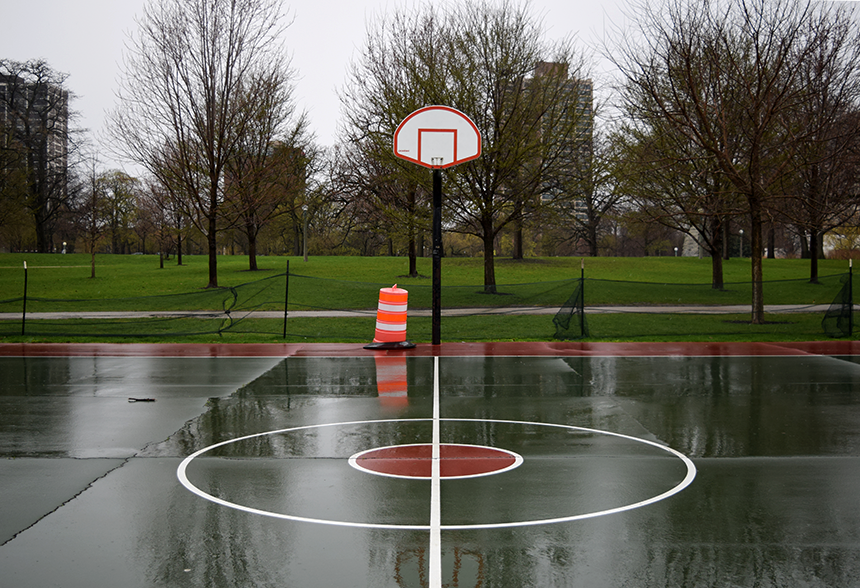In a tired neighborhood park near my school, chain-linked fences cradle patches of overgrown grass and weathered wooden benches line the walking path where the evening welcomes passersby in ginger light, softening the coarse expressions they’ve evolved to carry. The first time I visited this place was during the last winter break of high school — the temperatures just low enough to frost the redbud trees along the sidewalks. Across the street from me sat a man with sun-stained skin who, every few minutes, would punctuate the air with a dry, stifled wheeze before coughing up blood. I found myself holding my breath between his coughs, my own lungs tightening with each of his labored breaths. Each time his body convulsed with another cough, I felt the urge to both turn away and draw closer, caught in that delicate space between respect for his privacy and an inexplicable need to bear witness. I would pretend to read my book, pages turning too quickly to actually absorb any words. Sometimes our eyes would meet briefly, and in those moments, I wondered if my presence was an unwanted reminder of his vulnerability or if perhaps there was comfort in not being entirely alone with his pain. I learned to sit in that contradiction, to understand how witnessing can be both an intrusion and an act of care.
There were other regulars too, their routines as predictable as the changing shadows across the park’s uneven ground. A group of elderly men would gather near the chess tables each morning, their conversations drifting between Spanish and English, their laughter carrying across the morning stillness. I would often sit nearby, pretending to read while actually studying their weathered hands as they moved pieces across the board, each gesture containing decades of similar mornings, similar moves. Sometimes they would glance my way, offering a nod or a smile, and I would feel simultaneously seen and invisible – exactly how I preferred to exist in this space.
I didn’t return to the park for a while, but when I did, I began to recognize patterns. There’s the elderly woman who would come every Tuesday with a paperback novel and a thermos of tea, her silver hair catching the morning light as she turns each page with careful deliberation. Sometimes she’ll suddenly pause, gazing at nothing in particular, as if the words have triggered memories she’d rather not disturb. Some days she marks her place with a pressed flower, other times with old receipts or faded photographs that peek out from between the pages. Her wedding ring, loose now on her finger, spinning absently as she reads.
Every weekend near the playground, a father would teach his daughter to ride a bicycle, his hands hovering protectively near her shoulders as she wobbled forward with her hands encased in a white-knuckled grip on the handlebars. From my bench beneath the maple tree, I found myself leaning forward slightly with each of her attempts, my own body remembering the precise moment between falling and flying. Their shadows stretch long across the cracked pavement, merging and separating with each pedal stroke. When she occasionally finds her balance and rides freely, her father’s face holds expressions of joy.
Other moments also require us to release what we’ve always known, trusting the path ahead even as it curves away from familiar ground. On a quiet afternoon, I witnessed another kind of letting go. A young couple sat across from one another with faces painted by distant stares, as if waiting for the reality of the moment to dawn. After a few still moments passed, tears welled in their eyes, leaving them to shift uncomfortably under the weight of a crushing silence. After exchanging a few words, they stood up, pushed in their chairs, and left. Chunks of broken vows still too lodged in their throats to tell each other goodbye.
Between the rusted swings and chain-link fences, I find myself drawn to the raw humanity that unfolds here. In this tired neighborhood park, I’ve found an unexpected directed reading in storytelling. The man with his blood-stained coughs taught me not about mortality, as I first thought, but about the strange avenues to connection — how I began to hold my breath between his coughs, my body syncing with his suffering in a way that made me understand how intimacy can form without words.
The chess players near the concrete tables showed me something similar in their own way – they never spoke above murmurs, but their hands moved with such familiarity over the boards that words seemed unnecessary. When one would capture a piece, he’d hold it a moment too long, turning it over in his fingers before setting it aside, as if remembering all the other games where that same piece had met the same fate.
From the silver-haired woman’s idle ring-spinning, I learned not about loss but about how stories live in the smallest gestures – how sometimes the most revealing moment isn’t in the dramatic pause of her reading but in that unconscious fidgeting.
The father and daughter with their bicycle lessons showed me something unexpected about writing itself – not the obvious metaphor about learning and letting go, but about how stories exist in the space between people, in the curved air between his hovering hands and her shoulders, in the merging and separating of shadows that speak more truth than their actual movements. And that couple with their crushing silence – they taught me that sometimes the story isn’t in what’s breaking, but in how people arrange their bodies around an absence, how they navigate the negative space of what’s no longer there.
Here, among these weathered benches and overgrown grass, I’ve learned that observation isn’t about watching for the obvious turning points but about catching the small, strange moments that reveal how we carry our stories in our bodies, in our unconscious movements, in the subtle and unguarded moments of simply living our lives.
